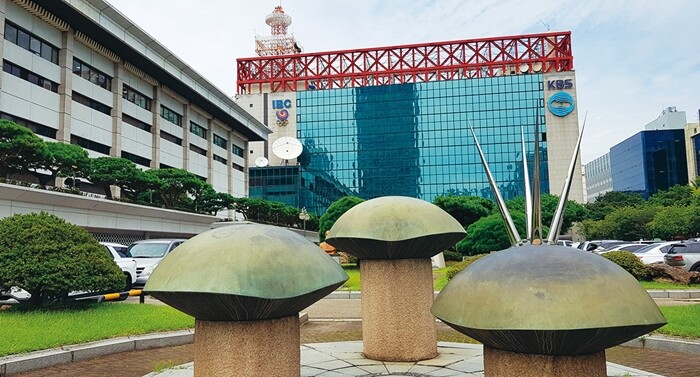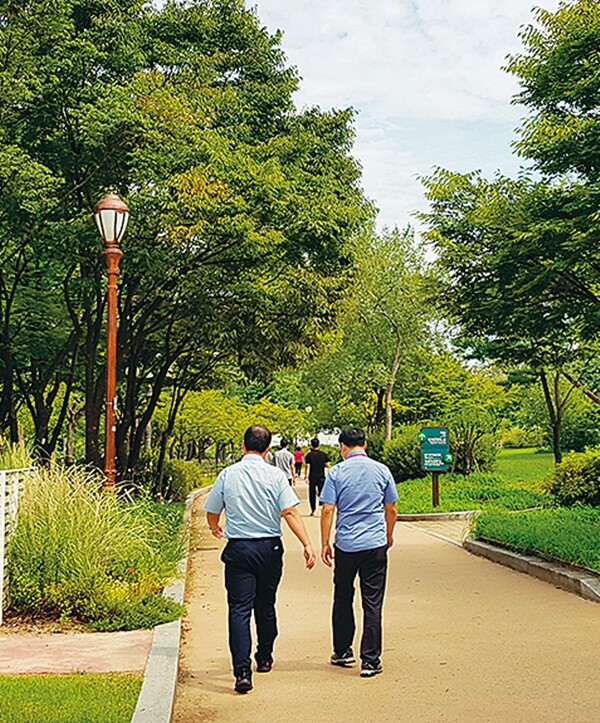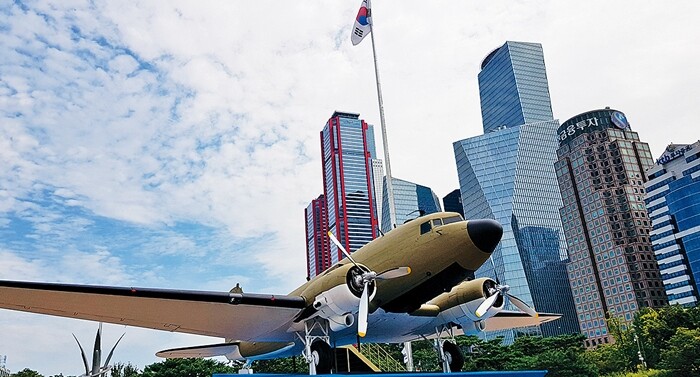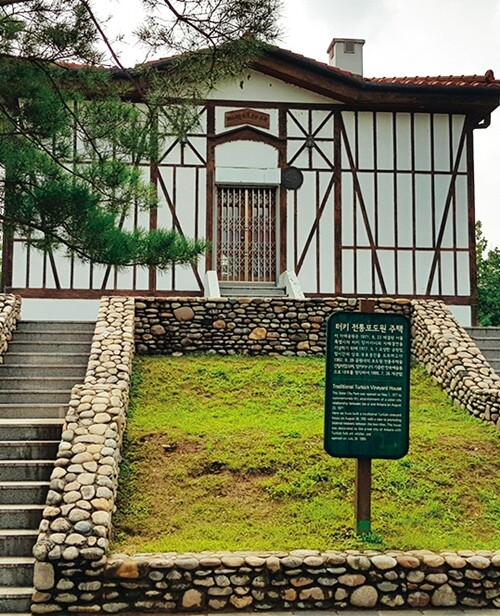hankyoreh
Links to other country sites 다른 나라 사이트 링크
[Seoul travels]Glimpsing innovation and the new “sexy” at the birthplace of the Korean Wave

I’m toiling away at my desk when I can no longer resist the temptation of this gorgeous weather. And so I find myself boarding the Seoul subway, bound for Yeouido.
The island of Yeouido, on the Han River in central Seoul, is often compared to Manhattan, in New York. For one thing, it’s the center of Korea’s banking and finance, with its stock exchange and financial regulators. For another, it’s home to broadcasters, a beautiful river, and two gorgeous parks. Just as Manhattan boasts Central Park and Bryant Park, Yeouido has its eponymous Yeouido Park, as well as Ankara (Jamae) Park.

Those who work in Yeouido call themselves “islanders.” As that suggests, Yeouido has its own culture, sentiment, and vibe. While I’ve been connected to that “island culture” for 30 years now, I make up my mind to encounter Yeouido once again, focusing on its two parks. I disembark from the subway at National Assembly Station, one of four subway stops on the island, and emerge from Exit 4. Walking forward, with the National Assembly to my back, would take me straight to the sweeping expanse of Yeouido Park, but first, I head toward the KBS broadcast studio to my right. Seeing the crowds of passionate fans lined up outside, I realize some kind of pop concert is being broadcast today. As broadcast time draws closer, Hollys Coffee and other cafés near the studio entrance transform into rendezvous spots for agency managers.

Yeouido is the birthplace of Hallyu, or the Korean Wave. The island used to be home to Korea’s three terrestrial broadcasters — KBS, MBC, and SBS — and it was where many of Korea’s best-known dramas were made, such as “Dae Jang Geum,” directed by Lee Byung-hoon, and “Winter Sonata,” starring Bae Yong-joon. The Korean Wave has its haters who attribute all its successes to dumb luck, but I don’t agree at all. Hallyu has close ties to the sexy culture of Yeouido. To make sure there’s no confusion, when I say “sexy,” I’m not just talking about carnal desire. I’m using it in the sense of former Berlin Mayor Klaus Wowereit, who once said that “Berlin is poor, but sexy.” I’m talking about having original ideas, expressing them in creative ways, and presenting a unique lifestyle. Sexy thinking, revolutionary style, and abundant initiative — that was Yeouido in its heyday.
Videos are ignored unless they’re sexy. Old-fashioned methods of story-telling and clichéd content won’t keep eyes on the screen for a single minute. The Hallyu dramas resulted from mixing Korea’s “kimchi” sensibilities into the broader Asian traditions of chopstick culture and family values, which were then presented in the rags-to-riches stories beloved by contemporary audiences. The handful of colors that plastered the screen in historical dramas of yesteryear were updated with a profuse palette of colors, while the sedate speaking style was replaced with a more energetic modern register. By boldly deconstructing traditional source materials and reimagining them in sensual imagery, Hallyu historical dramas were able to grab the attention of people around the world. What I’m saying is that this deconstruction was the chief contributor to the birth of Hallyu as well as the key element of the “sexy island culture” of Yeouido. Unfortunately, Yeouido has now lost the initiative to Gangnam.

Moving past KBS, I arrive at Yeouido Park. It’s around lunchtime, and the area is dotted with people carrying lunch boxes and sandwiches and office workers out for a stroll. The National Assembly was built in Yeouido in 1969, and the May 16 Square was built two years later. This asphalt square, which had often been used by demonstrators and cyclists, was turned into the green space we have today by Cho Soon, the first democratically elected mayor of Seoul. Reborn as Yeouido Park in 1999, the park is popular for its 3.9km walking path and 2.4km bicycle route.
There’s a big propeller plane in the middle of the park. As it happens, this C-47 bore witness to several dramatic episodes in Korea’s contemporary history. It landed on Yeouido Square on Aug. 18, 1945, shortly after Korea’s liberation from Japanese rule, carrying agents with the US Office of Strategic Services and four members of the Korean Liberation Army. On Nov. 23 of that year, the same plane touched down at a landing strip in Gimpo, repatriating 15 key figures from Korea’s provisional government, including Kim Koo. In 1916, the Japanese army built a runway and hanger in Yeouido and used it as an alternate airport for Seoul (then called Gyeongseong). Even after liberation, the site was used as an airport for the private sector. In short, Yeouido’s links with the outside world go way back.

Following my stroll through Yeouido Park, I walk across the square in the direction of the FKI Tower, headquarters of the Federation of Korean Industries. The latest incarnation of the FKI’s headquarters has 51 stories, making it a new landmark. When the original headquarters was completed back in 1979, former President Park Chung-hee wasn’t able to attend the ribbon-cutting ceremony as planned: he was assassinated on Oct. 26 of that year. But Park’s handwritten message “creation, cooperation, prosperity” was still inscribed on a monument that stands behind the headquarters, in front of the Plaza Apartments. There are quite a few older apartment buildings in Yeouido, despite the reconstruction boom. The names of the complexes are comfortingly familiar — Sambu, Sujeong, Miseong, Gongjak, Seoul — lacking the fancy English words that appear so often in the names of newer complexes. The residential population of Yeouido is on the decline, but it still has an elementary school, a middle school, and a high school.
I keep walking past Yeouido Station and eventually reach Saetgang Station, with Ankara Park just outside of Exit 3. Upon arriving, I find that the park signpost now says Jamae (Sister) Park. The building in the middle of the park is a house from a traditional Turkish vineyard, donated by the city of Ankara in 1977. On one side of the park is the KBS annex, while on the other side is the Yeongdeungpo 50 Plus Center, a public organization seeking to create a community for intellectual and cultural rejuvenation. In short, the park is a prized corner of the island that can simultaneously quench one’s cravings for knowledge, meaning, and fun.

Since I’ve been on my feet for a couple of hours now, the time has come to satisfy my hunger pangs. While Yeouido might seem like a dreary place, there are a surprising number of famous restaurants there. Shindongyang and Seogung are Chinese restaurants run by overseas Chinese; Jinjujib serves kongguksu (noodles served in chilled soy broth); Gumasan is best-known for its chueotang (loach soup) and barbecued ribs; Goryeojeong specializes in chadolbagi (thinly sliced beef brisket); Sanha serves dumpling dishes; and Shinsong features daegutang (cod stew). But I turn my steps to a grilled fish joint called Dami on the first floor of the Oryun Building. I’ve been going to this unassuming restaurant for more than 30 years now. As it so happens, this is the season for grilled jeoneo (gizzard shad); every year around this time, I make my way to the restaurant as a sort of autumnal ritual.
The Middle Ages ended when the doom and gloom of the Black Death gave way to the brilliant and sexy art that we see in painters such as Botticelli. When COVID-19 has passed, this land will see a renaissance of its own. Our job, until that time, is to shed hackneyed and outdated ways of doing things through a bold reinvention of ourselves. That’s right — we’ve got to be sexy if we want to survive.
By Son Kwan-seung, travel writer
Edited by the team at Seoul & (www.seouland.com)
Please direct comments or questions to [english@hani.co.kr]
Editorial・opinion
![[Column] Season 2 of special prosecutor probe may be coming to Korea soon [Column] Season 2 of special prosecutor probe may be coming to Korea soon](https://flexible.img.hani.co.kr/flexible/normal/500/300/imgdb/original/2024/0426/3317141030699447.jpg) [Column] Season 2 of special prosecutor probe may be coming to Korea soon
[Column] Season 2 of special prosecutor probe may be coming to Korea soon![[Column] Park Geun-hye déjà vu in Yoon Suk-yeol [Column] Park Geun-hye déjà vu in Yoon Suk-yeol](https://flexible.img.hani.co.kr/flexible/normal/500/300/imgdb/original/2024/0424/651713945113788.jpg) [Column] Park Geun-hye déjà vu in Yoon Suk-yeol
[Column] Park Geun-hye déjà vu in Yoon Suk-yeol- [Editorial] New weight of N. Korea’s nuclear threats makes dialogue all the more urgent
- [Guest essay] The real reason Korea’s new right wants to dub Rhee a founding father
- [Column] ‘Choson’: Is it time we start referring to N. Korea in its own terms?
- [Editorial] Japan’s rewriting of history with Korea has gone too far
- [Column] The president’s questionable capacity for dialogue
- [Column] Are chaebol firms just pizza pies for families to divvy up as they please?
- [Column] Has Korea, too, crossed the Rubicon on China?
- [Correspondent’s column] In Japan’s alliance with US, echoes of its past alliances with UK
Most viewed articles
- 1[Column] Season 2 of special prosecutor probe may be coming to Korea soon
- 2No good, very bad game for Korea puts it out of Olympics for first time since 1988
- 3‘We must say no’: Seoul defense chief on Korean, USFK involvement in hypothetical Taiwan crisis
- 4Division commander ordered troops to enter raging flood waters before Marine died, survivor says
- 5Is Japan about to snatch control of Line messenger from Korea’s Naver?
- 6Korea’s 1.3% growth in Q1 signals ‘textbook’ return to growth, says government
- 7Is N. Korea threatening to test nukes in response to possible new US-led sanctions body?
- 8[Editorial] Korea’s surprise Q1 growth requires objective assessment, not blind fanfare
- 9[Editorial] New weight of N. Korea’s nuclear threats makes dialogue all the more urgent
- 10[Editorial] In the year since the Sewol, our national community has drowned